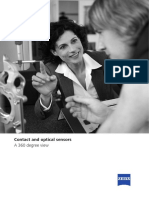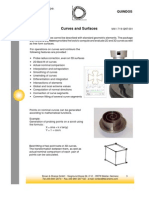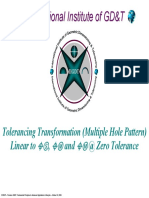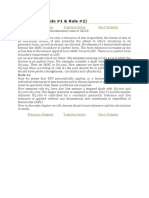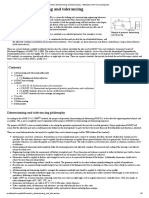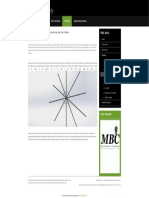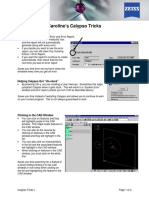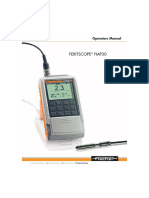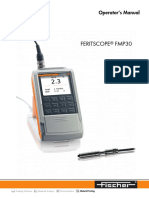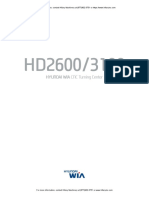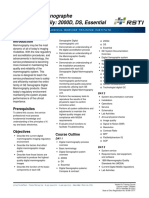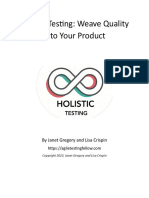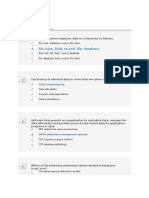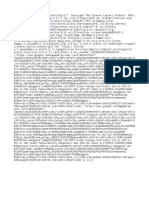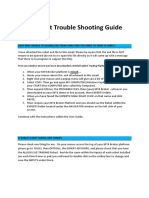ZEISS ACADEMY
METROLOGY
SENSOR
COOKBOOK
Qualifying ZEISS Sensors
Reading Sample
�Table of Contents
Introduction 9
Coordinate measuring machine and probe ..................................................10
Factors influencing the qualification result ...................................................11
Selecting styli ..............................................................................................12
Qualification principle..................................................................................13
Numbering the styli .....................................................................................14
Assembling styli...........................................................................................15
The stylus menu in CALYPSO .......................................................................16
Terms and modes ........................................................................................17
Manual stylus system change 18
Release stylus system manually ....................................................................18
Mount stylus system manually .....................................................................19
Reference sphere 20
Determining the position of the reference sphere,
all ZEISS measuring systems.........................................................................20
3
�Table of Contents
Measuring System VAST® / VAST® gold / VAST® XT / VAST® XT gold 22
Qualifying the first stylus .............................................................................22
Qualifying additional styli for the stylus system ............................................24
Configuring the stylus changing system .......................................................26
Automatically depositing the stylus system ..................................................28
Automatically changing the stylus system ....................................................29
Measuring System VAST® XTR gold 30
Qualifying the first stylus .............................................................................30
Qualifying additional styli and angular positions ..........................................32
Configuring the stylus changing system .......................................................34
Automatically depositing the stylus system ..................................................36
Automatically changing the stylus system ....................................................37
Incremental articulating system (RDS) 38
RDS geometry and fitting position ...............................................................38
4
�Table of Contents
Measuring System VAST® XXT / SP 25 39
Qualifying the first stylus (without RDS-CAA) .................................................39
Qualifying additional styli and angular positions (without RDS-CAA) ............40
Qualifying the first stylus (with RDS-CAA) ....................................................41
Qualifying additional styli (with RDS-CAA) ...................................................42
Configuring the stylus changing system .......................................................44
Automatically depositing the stylus system ..................................................46
Automatically changing the stylus system ....................................................47
Measuring System VAST® XXT: permanent installation 48
Qualifying the first stylus .............................................................................48
Qualifying additional styli for the stylus system ............................................49
Configuring the stylus changing system .......................................................50
Automatically depositing the stylus system ..................................................52
Automatically changing the stylus system ....................................................53
5
�Table of Contents
Measuring System VAST® XDT 54
Qualifying the first stylus (with/without RDS-CAA) .......................................54
Qualifying additional styli for the stylus system (with/without RDS-CAA) .......56
Configuring the stylus changing system .......................................................58
Automatically depositing the stylus system ..................................................60
Automatically changing the stylus system ....................................................61
Measuring System VAST® XDT: permanent installation 62
Qualifying the first stylus .............................................................................62
Qualifying additional styli for the stylus system ............................................63
Configuring the stylus changing system .......................................................64
Automatically depositing the stylus system ..................................................66
Automatically changing the stylus system ....................................................67
Result and stylus data 68
Inspection and report ..................................................................................68
Monitor, delete, edit....................................................................................70
6
�Table of Contents
Adapter plate ID chip 71
Configuration ..............................................................................................71
Automatic qualification 72
Follow-up qualification ................................................................................72
Qualifying any stylus system ........................................................................73
Qualifying special styli 74
Stylus correction: disk stylus ........................................................................74
Stylus correction: cylinder stylus ..................................................................75
7
�General information about this cookbook
This version of the cookbook also uses videos to illustrate the process for the most common recipes and procedu-
res.
The QR codes in the cookbook provide easy access to these videos. Alternatively you can watch these videos di-
rectly on the ZEISS Academy Metrology YouTube channel at: https://www.youtube.com/c/ZeissAcademyMetrology.
QR codes can be scanned with the camera on all common mobile devices (e.g. smartphones and tablets). This
requires an app that can process QR codes. Most of these apps are available for free at the particular app store for
your device.
Example of a QR code:
Note concerning the video content: The videos are for illustrative purposes only and must always be used in
combination with the particular cookbook recipe.
The content shown uses coordinate measuring machines and software with standard configurations from ZEISS.
Should a customized configuration be used at your company, the content shown in the video may differ from your
company-specific procedure. Regarding liability, please refer to the cookbook's legal notice.
8
�Reference sphere
Determining the position of the reference sphere,
all ZEISS measuring systems
1 Preparation
Switch on and reference the coordinate measuring system. Acclimate and insert the master probe.
With RDS, qualify fitting position.
Image 1
Qualifying the stylus system.
Select stylus 1. (With RDS, rotate to angular position A/B: 0°/0°; with VAST XTR, rotate to angular
position "0").
Reference sphere position.
2 Position the reference sphere
Position the reference sphere on the fixture.
The reference sphere must be positioned in such a way that it can be used with the stylus system to be
qualified without causing a collision.
3 Specifying the shaft direction of the reference sphere (image 1)
a: active sensor mode: tensor
p: passive sensor mode: qualify passive stylus
Touch-trigger sensor mode: 6 points
Qualify or assign the tilt and rotation angle of the reference sphere shaft via the "Qualify stylus system"
and "Reference sphere position" functions.
Sphere Method
Image 2
Traditional sphere Method 1 (see following page) a: active sensor
RSH sphere Method 2 (see following page)
4 Specify the probing force and probing dynamics (image 2)
Input the probing force and probing dynamics used for the qualification.
Sensor Probing force Probing dynamics p: passive sensor
a: active sensor 200 mN (standard) 100 %
p: passive sensor Standard 100 %
5 Probe the reference sphere in the direction of the shaft
When prompted, the reference sphere is probed at the highest point in the direction of the shaft.
The qualification is performed automatically.
20 QT050 All content and strategies © Carl Zeiss Industrielle Messtechnik GmbH 8/2017
�Reference sphere
Determining position of the reference sphere, all
ZEISS measuring systems
Method 1
Traditional sphere
The direction of the reference sphere shaft must be input manually via the elevation angle (angle
between the Z axis of the measuring system and the reference sphere shaft) and manually via the
rotation angle (angle between the X axis of the measuring system and the reference sphere shaft) or by
clicking on the symbols.
Method 2
RSH sphere
The direction of the reference sphere shaft must be qualified via the RSH shaft definition.
The sphere on the sphere holder and the reference sphere itself are probed using one point each on a
free spherical section as instructed.
http://www.youtube.com/
c/ZeissAcademyMetrology
All content and strategies © Carl Zeiss Industrielle Messtechnik GmbH 8/2017 QT050 21
�Measuring System VAST® / VAST® gold / VAST® XT / VAST® XT gold
Qualifying the first stylus
1 Preparation
The reference sphere position is defined.
The stylus system used is configured, acclimated and cleaned.
4 Specify the probing force and probing dynamics
Use the "Qualify stylus" function.
Input the probing force and probing dynamics used for the qualification.
2 Load the stylus system
Load the stylus system.
Stipulate the mode to be used for the qualification.
Mode Application Mode Probing Dynamics
Dyn. tensor With Vast Navigator option. After qualifying the stylus, the radius, the force
position of the stylus tip and the dynamic bending properties of the stylus Standard 200 mN 100 %
are identified. Soft/unstable
workpieces or
Tensor Standard method. After qualifying the stylus, the radius, the position of 100 mN 50 %
long stylus shafts
the stylus tip and the bending properties of the stylus are identified. < 1 mm diameter
Quick
> 200 mN 100 %
Six points Fast method. For measurements with lower accuracy requirements. After external scanning
qualifying the stylus, the radius and position of the stylus tip are identi- These values are recommendations and must be modi-
fied. fied to accommodate the particular situation!
Manual Method for manually capturing the qualification points.
Generally used for disks, cylinders and temperature probes.
After qualifying the stylus, the radius and position of the stylus tip are
identified.
5 Probe the reference sphere in the direction of the shaft
When prompted, the reference sphere is probed at the highest point in the direction of the
shaft. With styli that are arranged diagonally to the measuring system axes, the
calculated angles must be approved by clicking on "OK." The qualification is
performed automatically.
3 Geometry of the stylus tip
Stipulate the geometry of the stylus tip to be used for the qualification. See following page.
6 Result
The result of the qualification is logged and should be checked.
http://www.youtube.com/
c/ZeissAcademyMetrology
22 QT110 All content and strategies © Carl Zeiss Industrielle Messtechnik GmbH 8/2017
�Measuring System VAST® / VAST® gold / VAST® XT / VAST® XT gold
Tables
Mode Geometry Procedure Mode Geometry Procedure
Dyn. tensor Sphere Probe in the shaft direction. In the dyn. tensor Manual Disk Probe the first point in the direction of the shaft in
mode, 15 points are automatically measured twice order to specify this. Probe 4 additional points at 2
with different probing forces. Then a scan is per- different heights near the equator twice.
formed at 2 different speeds across the pole and Stylus correction, see QT930.
the equator of the sphere.
Tensor Sphere Probe in the shaft direction. In the tensor mode,
15 points are automatically measured twice with Manual Cylinder Probe the first point in the direction of the shaft
different probing forces. in order to specify this. Probe 3 points once, then
4 additional points at 2 different heights at the
Six points Sphere Probe in the shaft direction. In the 6-point mode, equator.
6 probing points are automatically measured for Stylus correction, see QT940.
the geometry specification.
Manual Sphere Probe the first point in the direction of the shaft
in order to specify this. Probe at least 6 additional
points distributed over the half sphere.
Manual Temperature probe Probe the highest point of the reference sphere in
VAST® gold the direction of the shaft.
All content and strategies © Carl Zeiss Industrielle Messtechnik GmbH 8/2017 QT110 23
�SENSOR COOKBOOK
Would you like to have access to the whole Sensor
Cookbook? Simply scan the following QR-code und
order the Sensor Cookbook in our webshop.
https://us.probes.zeiss.com/en/Training-Material/Books/ZEISS-Sensor-
Cookbook/category-1012/product-ARTIKEL_4481.html
